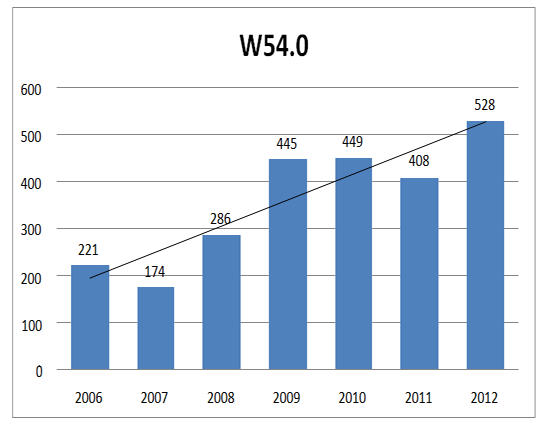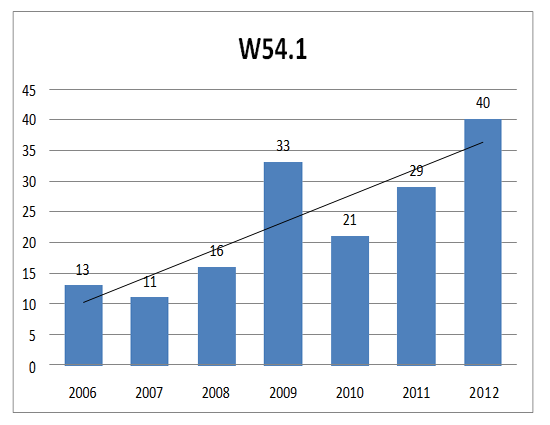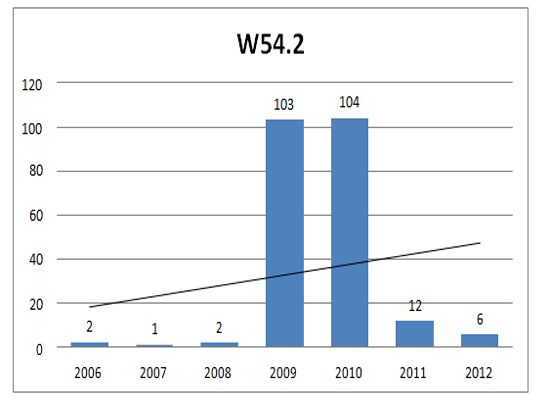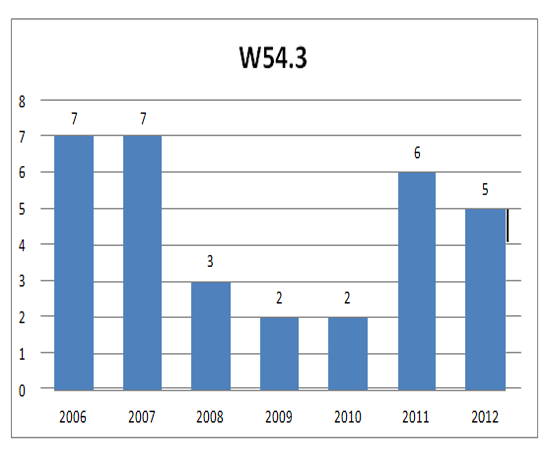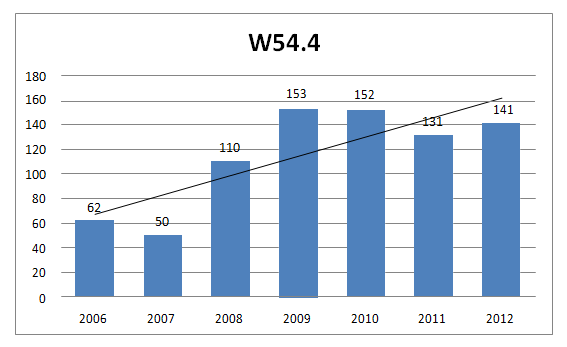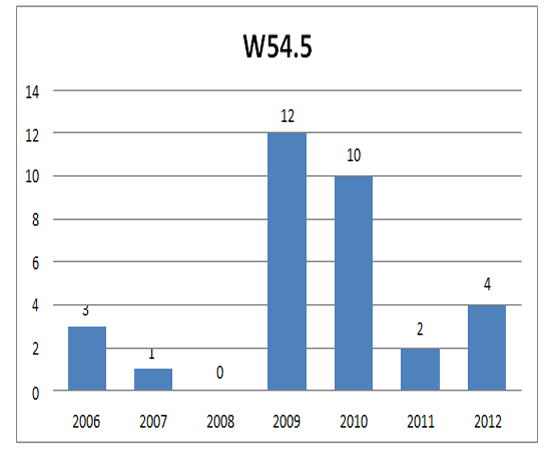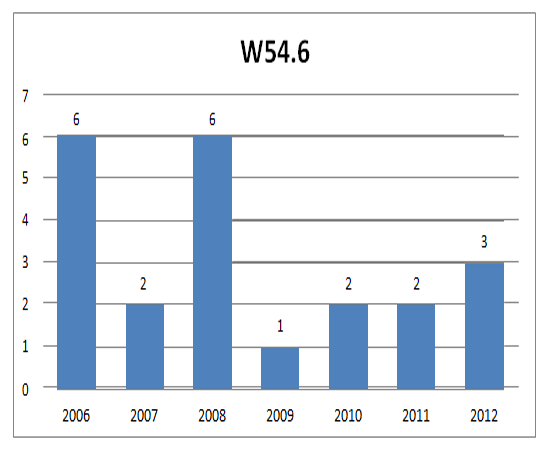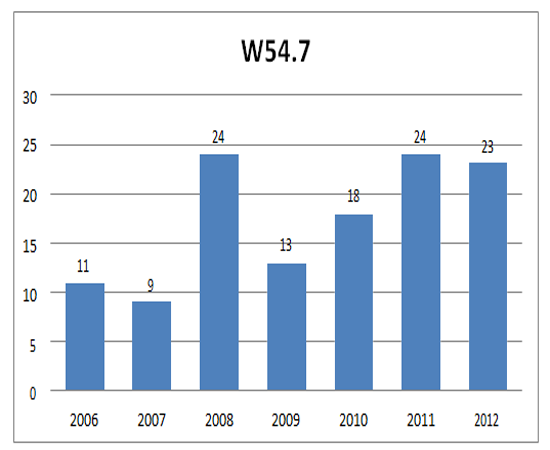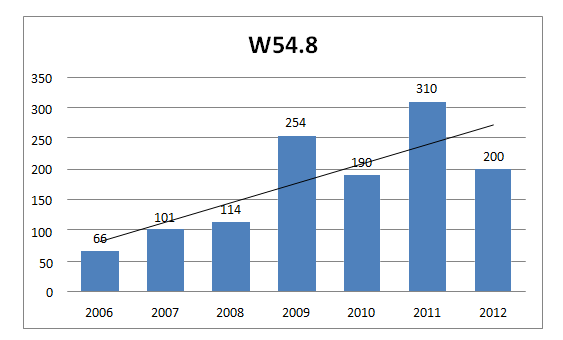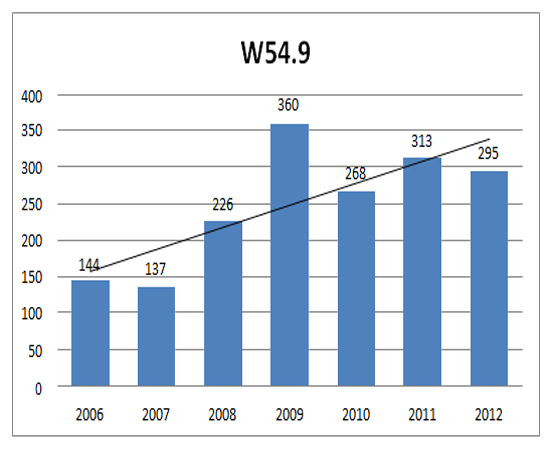Information
Journal Policies
Important to Forensic Medicine Statistical Trends in Hospital Admissions of Patents Bitten and Struck by Dogs (W54 ICD-10) in the Lower Silesia Region of Poland in the Years 2006-2012
Robert Suslo¹, Piotr Nowicki², Jaroslaw Drobnik¹
2 Management, Autonomous Clinical Hospital, Wroclaw, Poland
Copyright : © 2016 Suslo R. This is an open access article distributed under the Creative Commons Attribution License, which permits unrestricted use, distribution, and reproduction in any medium, provided the original work is properly cited.
Abstract
Exposure to animate non-human mechanical forces shall theoretically become less and less frequent with the progress of civilization - as there are less and less animals in the humans nearest environment, especially wild or uncontrolled ones. However, as the society wealth grows it is becoming more and more popular to keep pets of different sorts. Also leisure time activities in open spaces reopen possibilities of contacts between humans and wild and stray animals. All this increases the risk of incidents resulting in humans harmed by animals. Data on causes of hospital admissions because of dog bite and strike incidents (W54 according to ICD-10) in the years 2006-2012, made available due to courtesy of the public healthcare insurance provider Narodowy Fundusz Zdrowia in Lower Silesia region of Poland (NFZ), were analyzed to find out the current incidence and trends in dog bite and strike incidents in the analyzed period of time in order to equip clinical and forensic medicine as well as public health specialists with the current basis for decision making. The study revealed that the data on the Lower Silesia region of Poland are consistent with parameters characterizing other developed countries of the world: in the analyzed years there was significant and dynamic increase in the amount of dog bite and strike incidents resulting in hospital admissions – especially at inhabited premises and roads. Keeping dogs as pets is very popular in Poland and thus the contacts between dogs and humans are common; unfortunately there is concurrently the lack of effective legal mechanisms of limiting pets abandonment with the resulting significant amount of stray animals. Such uncontrolled dogs are likely to trouble people in the common spaces; the study demonstrated that there exists a time association between the rise in amount of dog incidents and Polish population life-style changes, including the growing popularity of activities in the open air, especially everyday bicycle use that is being strongly encouraged also by Polish law starting from the year 2009. On the contrary, the risk of serious incidents involving dogs at trade, service, industrial and construction areas as well as at schools, other institutions and public administrative areas of Lower Silesia region of Poland shall be considered as minimal. Along with the increase in amount of bite incidents there is rising demand for the services of forensic dentistry experts in Poland.
Keywords: Forensic Medicine; Dog Bite; Forensic Dentistry; Bite Marks
Abbreviations: NFZ - Narodowy Fundusz Zdrowia in Lower Silesia region of Poland, District Division in Wroclaw
1.Introduction
Exposure to animate non-human mechanical forces shall theoretically become less and less frequent with the progress of civilization - as there are less and less animals in the nearest environment, especially wild or uncontrolled ones. However, keeping pets of different sorts at home became in the last decades more popular than ever because of both: wealth growth and cultural changes in modern societies. Moreover, well known pets - like dogs, cats or goldfishes - are often replaced with more exotic, often very expensive, animals of various arts. They are imported nearly from all around the globe - like snakes, reptiles, scorpions, spiders or venomous fishes - and the place of domestic dog breeds is taken by foreign ones; it turned out many times already that numerous of these pets were dangerous even to their owners. In the year 2003 in the USA, at that time inhabited by around 297 million people, it was estimated that 62% of all households were keeping at least one pet, which translated into: 77 million cats, 65 million dogs, 16 million small animals, 17 million birds, 8 million reptiles, 7 million saltwater fish and 185 million freshwater fish [1]. Along with the healthy lifestyle also leisure time activities in the open air became more and more common. Although this trend shall be considered generally positive it also reopened vast possibilities for humans to come into contacts with stray, or even wild, animals - including the risk of being bitten by them. Bicycle riders are readily bitten by dogs and in the year 2010 in Poland 9,3% of surveyed citizens declared that they use bicycle as the main everyday transportation means - which exceeded the European average of 7,4% - and the amount of bicycles sold yearly still dynamically increased in the last decades [2]. At the same time, there persists, also in Poland, the recurring problem of seasonal abandonment of pets by their owners, often performed in cruel ways. It raises the amount of stray dogs which sometimes attack people and under special circumstances can even cause epidemic threat, including rabies. The situation results mainly from both: lack of laws enforcing obligatory identification chip implanting and ineffective punishment execution system in cases of animals’ abandonment [3]. In Poland there are living around 7 million dogs - compared to the human population of around 38 million [4].
Although for many thousands years now dogs are considered the best human species companions, cases of dog bites are still not uncommon - especially among children [5]. Above 80% of all animal bites received by humans in developed countries are precipitated by dogs; it is estimated that on average half of developed countries inhabitants will be bitten at least once-either by an animal or by another human - during their life span [6]. Around 1,5% of developed countries population gets bitten by dogs every year [7]. The lesions requiring medical assistance that were precipitated by dogs result in most cases from bites - which demand proper surgical evaluation as they have serious potential of developing septic complications [8].
Both DNA analysis and forensic dentistry play crucial roles in investigations of cases when humans get bitten by animals [9]. As the animal DNA is most often completely removed by medical activities and due to the passing time, and the characteristic features of bite wounds get altered by medical treatment and healing - it is needed that, as soon as possible after the incident, medical staff collect the proper samples and document adequately the case in the medical files. Any lack in prompt medical personnel action in this field severely impairs the chances for proper forensic evaluation of the case – especially in cases when the medical files were filled in inappropriately [10]. Quite often the results of DNA analysis are used as final confirmatory means of the one particular suspected animal identity but this method is far too expensive to be used on big animals groups. In contrast, forensic dentistry expert opinion is comparatively cheap so it is commonly used as the preliminary method: it can be prepared quite fast even in case of big comparison group and it results in narrowing the scope of search as it typically points at the sort and size of the animal involved. Moreover, in numerous situations - when the amount of possible culprits is not too big and the animals vary significantly from each other, particularly in size and age - this kind of expertise is capable of determining reliably the single animal that actually precipitated the bite mark in question [9].
Forensic dentistry is using methods that were developed first by dental anthropologists to document the diversity of human population [11] and it is successfully applied in forensic human identification, including the most complicated cases of exhumed remains [12]. Teeth of all mammals are hard and stable structures and their sizes and shapes, as well as positions they assume in the dental arch, form combinations that are practically unique for the given single animal or person [13]. Animal bite marks differ in many aspects significantly from those caused by humans - but correct identification of the particular animal species or even dog race tends to cause a lot of problems, although-as it was mentioned before - even individual identification of a particular animal is possible in some cases [9]. It is possible in a significant part because of numerous macroscopically recognizable dental anomalies that cause differences in bite marks patterns - which was proven also by studies in humans [14]. In many cases the bite marks provide as unique and trustworthy identification as fingerprints thus they are very important to forensic activities – the methodology of acquiring and using this kind of data was developed primarily for the purposes of criminal inquiries and personal identification of humans. The identification of the particular animal as the one that caused the given bite mark more and more often requires not only classic forensic dentistry expertise but also computer assisted or fully digital confirmative analysis; the latter is possible only in case the bite mark was suitably documented. The possible results provided by the forensic dentistry expertise include: positive or possible identification, exclusion or statement of insufficient evidence [9]. According to the American Board of Forensic Odontostomatology the analysis of bite marks requires obtaining history and photographic evidence, performing extra- and intraoral examination, collecting impressions, performing sample- bites and study casts. Sometimes the characteristic marks on the victim body that helped at identification efforts were left not by the animal teeth but items worn by it, like dog necklace [5].
In the recent decades in many developed countries, including the USA, there were reports of significant rise in number of dog bites cases [15]. It is important not only for public health and law enforcement, but also from the animal rights protection point of view - as the involved, or falsely blamed, dogs often undergo euthanasia or end up locked in animal shelters [16].
2. Materials and Methods
Data on causes of hospital admissions because of dog bite and strike incidents (W54 according to ICD-10) in the years 2006-2012, made available due to courtesy of the public healthcare insurance provider Narodowy Fundusz Zdrowia in Lower Silesia region of Poland (NFZ), were analyzed; the data included all admissions to hospital regardless of the subsequent hospital stay duration length. The statistical analysis was performed using Microsoft Office Excel 2007. The aim of the study was to find out the current incidence and trends in dog bite and strike incidents in the analyzed period of time to equip clinical and forensic medicine as well as public health specialists with the current basis for decision making.
3. Results and Discussion
The significant specifications of the population, like amount or age structure, of the Lower Silesia region of Poland were not changed in the years 2006-2012 although phenomena associated with population ageing effects were observed [17]. According to the year 2014 the region was inhabited by 2,9 million people, 48% of them males [18].
The study revealed that in the Lower Silesia region of Poland in the years 2006-2012 the total amount of registered hospital admissions following incidents of humans bitten or struck by dog, without any further specification in reports (W54 according to ICD 10) reached 14391 cases; the yearly amount of such cases increased to 258,1% of the initial value and demonstrated rising trend – as it is shown in Figure 1. It was consistent with the trends reported by other developed countries.
The total amount of dog bite or strike incidents at home that required subsequent hospitalization (W54.0 according to ICD-10) in the analyzed years reached 2511 cases; the yearly amounts of such cases demonstrated a consistent rising trend in the analyzed years, and in the end of the analyzed period reached 238,9% of the initial value – as it is illustrated in Figure 2. The total amount of patients admitted to hospitals because of similar incidents at residential institution (W54.1 according to ICD-10) was 163 in the analyzed years; the yearly amounts of cases of this type rose in the years 2006- 2012 to 307,7% of the initial value – as it is shown in Figure 3. It is consistent with both rising interest in keeping pets at homes and the growing amount of dogs of untypical breeds that are not suited for in-house keeping.
The data on hospitalizations caused by dogs biting or striking people at school, other institution and public administrative area (W54.2 according to ICD-10) are raising suspicions - there might have been a flaw in statistical data reporting by the medical institutions as there are unexplained peaks in the years 2009 and 2010: with values equal to 5150% of those reported in previous year and 866,7% of those registered in the next year – as it is illustrated in Figure 4. The authors were able to verify neither the possible flaw in reporting nor its causes. Taking aside those inconsistent data the number of cases in all other analyzed years was as little as 23; it may be stated that incidents of dogs biting or striking people at schools, other institutions and public administrative areas are typically very rare in the Lower Silesia region of Poland. Also cases when a person was bitten or struck by dog at sports and athletics area and required hospital admission (W54.3 according to ICD-10) were rare in the Lower Silesia region of Poland, with the total amount of 32 in the analyzed years – as it is demonstrated in Figure 5. Those findings are logically supported by the fact that the above-mentioned institutions are typically under constant surveillance and thus unattended dogs constitute a rare finding there.
The total amount of registered incidents of dog bite or strike that happened at street and highway (W54.4 according to ICD-10) in the years 2006-2012 was 799; the yearly amount of such cases rose in the analyzed years to 227,4% of its initial value, with significant increase in the year 2008 – as it is shown in Figure 6. There is a visible time association with the phenomenon of rapidly growing popularity of bicycle riding in Poland which exposes people to increased risk of receiving dog bites and strikes – in the year 2008 in Poland there were introduced new road traffic legal regulations that are highly convenient to cyclists and thus strongly encouraged every day use of bicycles.
Hospital admissions due to dog bite or strike incidents at trade and service area (W54.5 according to ICD-10) as well as at industrial and construction area (W54.6 according to ICD-10) were rare, with total cases amounts in the analyzed years of: 32 and 22, respectively – as it is demonstrated in Figures 7 and 8. In Poland numerous security agencies still use dogs running loose within restricted areas as aids at large objects supervision and it may explain some accidental dog bite incidents.
The total amount of hospitalizations resulting from situations when people were bitten or struck by dog at farm (W54.7 according to ICD-10) in the analyzed period equaled 122; the yearly amount of cases of this type increased to 209,1% of its initial value – as it is illustrated in Figure 9. This result is consistent with the fact that in Poland many farms are poorly fenced and in many areas dogs are still popular among farm owners as cheap alternative to electronic alarm systems.
The yearly amount of hospital admissions caused by dog bites and strikes at specified places other than home, residential institution, school, other institution, public administrative area, sports and athletic area, industrial and construction area or farm (W54.8 according to ICD-10) in the analyzed period increased to 303,3% of the initial amount, with a significant increase in the year 2009; the total amount of cases registered in the analyzed years was 1235 – as it is shown in Figure 10. Also the yearly amount of cases when patients were admitted to hospital because being bitten or struck by dog at unspecified place (W54.9 according to ICD-10) in the years 2006-2012 in the Lower Silesia region of Poland increased, to 204,9% of the initial value; there were 1743 cases of this type registered in the analyzed period – as it is demonstrated in Figure 11. Those results are supporting the thesis that dog bite incidents more and more often take place at untypical locations are present at many untypical locations - the presence of dogs in such places shall be in the first place associated with their abandonment by owners.
4.Conclusion
The analyzed data on hospital admissions in the Lower Silesia region of Poland in the years 2006- 2012 are consistent with the parameters characterizing other developed countries of the world: in the analyzed years there was significant and dynamic increase in amount of dog bite and strike incidents - both generally and at specific settings: at homes and residential institutions, on streets and highways, at farms and unspecified places. The rise in dog bite and strike incidents shall not be considered merely as the result of high popularity of keeping dogs as pets in Poland but also in the context of the negative phenomenon of their practically unpunished abandonment by owners, resulting in significant amount of stray animals in public places - and such uncontrolled dogs are most likely to trouble people. The study demonstrated time association between the rise in yearly hospitalizations of patients bitten or struck by dogs and Polish population dynamic life-style changes - including the growing popularity of activities in the open air, especially everyday bicycle use that is strongly encouraged by Polish law. Judging on the study results, the risk of serious incidents involving dogs at trade, service, industrial and construction areas as well as at schools, other institutions and public administrative areas of Lower Silesia region of Poland shall be considered as minimal.
The rise in yearly amount of dog bites and strike incidents in the Lower Silesia region of Poland increases the importance of medical personnel familiarity with the rules of handling the bite marks and wounds. It is crucial to include into the early medical activities both the urgent demands of rescuing patient’s health and at the same time also the need of evidence preserving for the purposes of forensic evaluation of the bite marks. Along with the increase in amount of bite incidents there is rising demand for the services of forensic dentistry experts in Poland.
5.Acknowledgments
The authors thank the NFZ for allowing them the access to the publication-relevant data.
References
- Grier K., Pets in America: A History, University of North Carolina Press, 2006, PP: 1-34
- Muter K., Polska – jak stajemy się rowerową potęgą, available on-line: http://polskanarowery. sport.pl/msrowery/1,105130,16372490, Polska jak_stajemy_sie_rowerowa_potega.html [accessed: 10.07.2016]
- Pawłowska A., Wakacje – czas pozbyć się psa, available on-line: http://wyborcza.pl/ 1,148125, 18279775,Wakacje czas_pozbyc_sie_psa Latem_porzucamy_nawet.html [accessed:10.07. 2016]
- Pawłowska A., Kołakowska O., W Polsce mamy 7 milionów psów, available on-line: http://wiadomosci.gazeta.pl/wiadomosci/1,114871,15152965,W_Polsce_mamy_7_milionow_pso w Co_wiemy_o_naszych.html [accessed: 10.07.2016]
- Shanbhag V., Significance of Dental Records in Personal Identification in Forensic Sciences., J Forensic Sci Med 2016, Vol 2, Issue 1, PP 39-43 DOI: http://dx.doi.org/10.4103/2349-5014.155551
- Griego R., Rosen T., Orengo I., Wolf J., Dog, Cat and Human Bites: a Review, J Am Acad Dermatol, 1995, Vol 33, Issue 6, PP 1019-1029 DOI: http://dx.doi.org/10.1016/0190-9622(95)90296-1
- Gilchrist J., Sacks J., White D., Kresnow M., Dog Bites: Sill a Problem?, Inj Prev, 2008, Vol 14,Issue 5, PP:296-301 DOI: http://dx.doi.org/10.1136/ip.2007.016220
- Suslo R., Drobnik J., Surgical Wound Closing and Care in: Steciwko A., Practical Skills for Primary Care Physicians, Akademia Medyczna im. Piastow Slaskich, 2011, PP 179-186
- Singal K., Significance of Forensic Dentistry in Crime Investigations; ARC Journal of Dental Science, Vol 1, Issue 1, 2016, PP 12-16 DOI: http://dx.doi.org/10.20431/2456-0030.0101005
- Suslo R., Swiatek B., Medical Data Security in Medico-Legal Opinioning, Arch Med Sad Krym, 2005, LV, PP 314-318 http://www.amsik.pl/archiwum/4_2005/4_05s.pdf
- Luna L., Some Achievements and Challenges of Dental Anthropology, ARC Journal of Dental Science, Vol 1, Issue 1, 2016, PP 5-9 DOI: http://dx.doi.org/10.20431/2456-0030.0101003
- Szleszkowski L, Thannhauser A, Szwagrzyk K, Konczewski P, Kawecki J, Swiatek B, Exhumation research concerning the victims of political repressions in 1945-1956 in Poland; a new direction in forensic mediicne, Forensic Sci Int, 2014, Vol 235, PP 103.e1-103.e6 DOI: http://dx.doi.org/10.1016/j.forsciint.2013.12.001
- Carreira L., The Contribution of Dentist and Dental Medical Records to Forensic Science, ARC Journal of Dental Science, 2016, Vol 1 Issue 3, PP 3-8 DOI: http://dx.doi.org /10.20431/2456-0030.0103002
- Al-Jawfi K., Ba-Salama M., Prevalence of Dental Anomalies among Schools Children i Sana’a City Yemen; ARC Journal of Dental Science, Vol 1, Issue 2, 2016, PP 16-21 DOI: http:// dx.doi.org/10.20431/2456-0030.0102004






